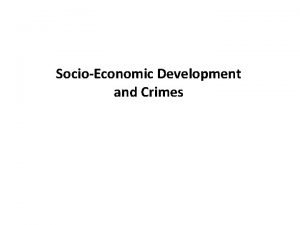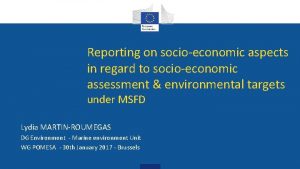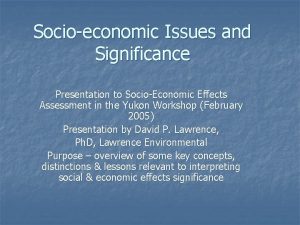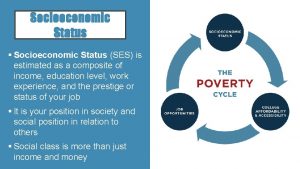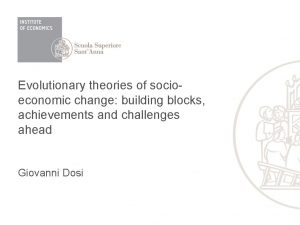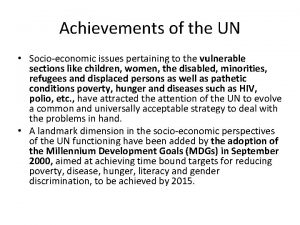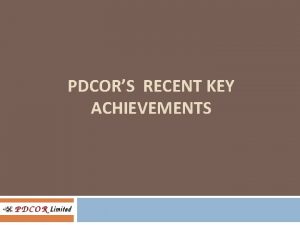Selected achievements of the Socioeconomic progress In the


















- Slides: 18

Selected achievements of the

Socio-economic progress In the period 2004 -2017, Poland, alongside Ireland Slovakia, posted one the highest cumulative GDP growth rates among the EU Member States. Since the EU accession the Polish economy has expanded by cumulative 71. 5%, while the average cumulative growth in the EU-28 economy amounted at the same time to 21. 2%. Implementation of development policies constitutes an important factor behind robust economic growth in the last few years, which leads to progressing convergence towards the EU-28 level of economic development. Moreover the forecasts for the short-term and mid-term period are promising. Rate of GDP Growth GDP per capita (at PPP), EU-28 average = 100 4. 8 4. 4 3. 8 3. 3 1. 6 2012 3. 1 3. 5 48 2019 2003 66 67 67 68 68 70 2012 2013 2014 2015 2016 2017 51 1. 4 2013 2014 2015 2016 Source: 2012 -2017 CSO, 2018 -2019 IMF Forecast 2017 2018 … 2006 … Source: CSO 2

Socio-economic progress Stronger macroeconomic fundamentals lead to increasingly positive perception of Poland by foreign business and international organizations: in October of 2018 the S&P upgraded rating of Poland’s sovereign debt (in foreign currency) from BBB+ to A- (October 2018), prooving that the current economic policies were effective. Additionaly Poland’s economy has enjoyed a stable rating outlook. The „Nation Brand” of Poland is also gaining in value, as Brand Finance The World’s Most Valuable Nation Brands shows: growing in 2018 by 14% and being assessed as AA- (similarly to Kuwait, Slovenia or Italy) and higher than Hungary (A) and Slovakia (A+) The World’s Most Valuable Nation Brands Country ratings Value (USD bn) 1. USA 25, 899 2. China 12, 779 Agency Rating (Longterm) 3. Germany 5, 147 Fitch A- 4. UK 3, 750 S&P A 2 5. Japan 3, 598 6. France 3, 224 Moody’s A- … 23. Poland Source: Brand Finance 654 Source: Ministry of Finance (Poland) 3

Socio-economic progress Poland is progressing in all major economic rankings – such as the World Economic Forum’s Global Competitiveness Index and the Doing Business Report. In WEF’s Global Competitiveenss Index Poland has significantly increased its competitive position: from 51 st in 2004/2005 to 39 th in 2017/2018. In recent years the country has upheld its position in the ranking. The gains have been largely due effective structural changes made to the public policies implementations (i. a. health; higher education; labour market). In the WB Doing Business report, Poland is constantly increasing its global competiveness. In 2018 the country was ranked 27 th. The gains were largely due to i. a. better insolvency settlements rules, paying taxes. Global Competitiveness Index (2017 -2018) Source: World Economic Forum Doing Business (2018) Source: World Bank / International Financial Corporation 4

Socio-economic progress Upon accession to the EU Poland was plagued by the highest unemployment rate in the European Union (19. 1%). However, in the years following the accession, the unemployment rate recorded fast improvement - declining to 4. 9% in 2017, when it was lower by 2. 7 p. p. than the EU-28 average figure. Declining unemployment and growing wages gave an impulse to robust growth in private consumption. It also helped to greatly reduce poverty – the percentage of population at risk of poverty and social exclusion significantly declined (by 11 p. p. in the period 2008 -2017). Population at risk of poverty and social exclusion (2008 – 2017) Total unemployement rate (2004 – 2017) 40 19. 1 2017 (%) change 2008 -2017 (p. p. ) 35 30 22. 5 25 19. 5 20 9. 7 9. 6 9. 3 10. 5 10. 310. 9 9. 7 10. 1 15 10. 2 9. 0 10 9. 4 8. 6 7. 5 5 0 6. 2 4. 9 -1. 2 -5 -10 EU-28 Source: European Commision Bulgaria Romania Greece Lithuania Italy Latvia Spain Hungary Cyprus Ireland Estonia Portugal EU Belgium Malta Germany Austria Luxembourg Poland 2017 Sweden 2016 Denmark 2015 Slovenia 2014 France 2013 Netherlands 2012 Slovakia 2011 Untited Kingdom Source: Eurostat 2010 Finland …. . Czechia 2004 Poland -11 -15 5

The effective use of ESIF (2004 -2018) Until the end of 2017, the Structural and Cohesion Fund resources in Poland have totaled approximately to PLN 381. 8 billion. The average annual volume of payments under the Cohesion Policy amounted in the analyzed period (2004 -2017) to 1. 9% of the GDP. As of 30 th September 2018, Poland is the leader in the case of payments made to EU Member States from ESIF 2014 -2020 (CF, ERDF, ESF, YEI). Progress in ESIF 2014 -2020 implementation Cohesion Policy Funds (2004 -2017) 70, 000 Cohesion Policy payments, in PLN million (left axis) In relation to the GDP, % (right axis) 3. 5% 60, 000 3. 0% 50, 000 2. 5% 40, 000 2. 0% 30, 000 1. 5% 20, 000 1. 0% 10, 000 0. 5% 0 0. 0% 2004 2005 2006 2007 2008 2009 2010 2011 2012 2013 2014 2015 2016 2017 Source: Ministry of Investment and Economic Development 6

The effective use of ESIF (2004 -2018) Source: European Commission 7

The Impact of the Cohesion Policy on the Social and Economic Development of Poland The impact of the Cohesion Policy on Poland's socio-economic development has been unequivocally positive. The European Funds exerted significant impact on economic growth, investment activity and the labor market in Poland, as well as on the internal and external equilibrium of the national economy. The EU financing served to support domestic investments and the development potentials of the Polish economy. The distance between Poland the EU-28 average in the GDP per capita (in the PPS) terms decreased markedly in the period 2004 -2017 (by 21. 5 p. p. ) of which 15% resulted from the Cohesion Policy’s implementation. The unemployment rate recorded fast improvement - declining to 4. 9% in 2017, of which 1. 3 p. p. resulted from the Cohesion Policy’s implementation. Impact of the Cohesion Policy on the GDP per capita, PPS, UE-28=100 Impact of the Cohesion Policy on the unemployment rate in Poland Estimated level of the GDP per capita (in PPS) in relation to the EU-28 average without the Cohesion Policy (%). . . 70 60 50 0. 1 0. 2 0. 7 1. 0 1. 7 2. 6 3. 2 3. 8 4. 1 4. 2 3. 6 3. 1 Impact of the Cohesion Policy (p. p. ). . . 20 15 10 40 30 5 20 0 10 -5 0 2004 2005 2006 2007 2008 2009 2010 2011 2012 2013 2014 2015 2016 2017 - 0. 0 - 0. 3 - 0. 7 - 0. 9 - 0. 8 - 1. 1 - 2. 0 - 2. 6 - 3. 0 - 3. 4 - 3. 1 - 2. 6 - 1. 9 - 1. 3 2004 2005 2006 2007 2008 2009 2010 2011 2012 2013 2014 2015 2016 2017 8

The tangible effects of ESIF in Poland Selected effects of ESIF implementation in Poland since 2004 Work and entreupreunership: • More than 1 mln unemployed received support • More than 40 ths. enterpises became beneficiaires of ESIF Research and development: • More than 5 ths. R&D projects financed • More than 2 ths. entities (Enterprises & Higher Education) received financial support Transport: • More than 12 ths. km of roads received up-grades or well built (highways, regional, subregional) • More than 1, 5 ths. km of railroads received up-grades or were built Health: • Innovations: • More than 2, 2 ths. product innovation(s) supported with ESIF • More than 1 ths. process innovation(s) supported with ESIF More than 120 ths. persons were covered with medical and treatment programs Removing barriers: • More than 60 ths. persons with disabilities received support 9

Financing growth through non-european means The mobilization of domestic sources of financing the development efforts (in congruence with the Strategy for Responsible Development) is observed, with, for example, growing share of domestic financial resources in the gross fixed capital formation expenditure of the sector of general government institutions (coupled with simultaneous decline in the share of the EU funds in the sector’s expenditures). Share of EU funds in the sector's of government and self government gross fixed capital formation expenditure 64% 67% 59% 57% 53% 32% 2012 2013 2014 2015 2016 2017 Source: Ministry of Investment and Economic Development 10

Poland has fallen into 5 development traps Three years ago, despite visible economic progress achieved - as evidenced by improving values of numerous macroeconomic indicators the Polish economy was facing five development traps. To overcome them and to create stronger foundations of economic development we are implementing the long-term national development strategy (Strategy for Responsible Development). This Strategy not only addresses the identified challenges, but also aims at harnessing, Poland's creative potentials by focusing nf the demanding vision of the future. • PLN 95 billion are transferred to foreign investors every year. • Polish GDP per capita is equal to not more than 45% of US GDP. • Half of the Polish population earn less than PLN 2. 5 thousand net. • Salary levels are equal to 1/3 of those in the developed countries. • VAT collection gap amounts to PLN 35 -55 billion. • CIT collection gap amounts to PLN 10 -40 billion. • Foreign liabilities amount to PLN 2 trillion. 1. Middle income trap 2. Imbalance trap • 2/3 of Polish exports are generated by foreign companies. • 50% of industrial production are generated by foreign companies. • R&D expenditure does not exceed 1% GDP. 5. Weak institutions trap • 44 amendments to the VAT Act since 2004. • No coordination of public policies. 4. Demographic trap 3. Average product trap • Only 6 Polish companies are world champions. • Only 13% of SMEs innovate(vs. 31% in the EU). • High-tech sectors account for not more than 5% of exports. • If the trend is not stopped, 2016 will initiate a continuous decline in the number of the working age population in Poland. • There are now 7 million people of pre-working age (aged 0 -17 years). In 20 years time, the number will decline to 5. 6 million.

The Role of the Strategy for Responsible Development The medium-term strategy for the country's development (adopted by the Council of Ministers on 14 Feb 2017) Defines a new model of development, main directions and goals Sets out the framework for the update of strategies & programmes and other implementation documents Lays down a system of coordination and implementation The instrument to flexibly manage main development processes in Poland (constitutes a list of the strategic and flagship projects) A base to conduct assessment of development strategies and programmes compliment with the SRD’s goals and provisions

New Development Model increased responsibility of state institutions for designing economic, social & territorial processes Lasting economic growth based on innovative companies. Multiplication of the Polish capital being a key to success. The best investment means investing in people. Responsible development is inclusive rather than exclusive. More efficient state. Responsible development is a development with an eye towards future generations. Solid public finance lay foundations for a development. Modern infrastructure to fulfil economic needs and enhance the quality of life. Responsible development is territorially sustainable. Strong economic operators are foundations of the economy.

The SRD’s Objectives Macroeconomic stability Main objective To create conditions for increasing incomes of the Polish citizens along with increasing cohesion in the social, economic, environmental and territorial dimension Specific objective III Sustainable economic growth increasingly driven by knowledge, data and organizational excellence Socially sensitive and territorially sustainable development Effective state and economic institutions contributing to growth as well as social and economic inclusion Areas having impact on the achievment of the Strategy objectives: Human and social capital, Digitization, Transport, Energy, Environment, National security 14

Main SRD’s Indicator Base value (base year) Current value (data for) Mid-term value (2020) Target value (2030) Source of data People at risk-of-poverty or social exclusion [%] 23. 4 (2015) 19. 5 (2017) 20. 00 17. 00 CSO Gini coefficient – distribution of income 30. 6 (2015) 29. 2 (2017) 30. 00 27. 00 CSO GDP per capita at PPP (EU 28=100) 68 (2015) 70 (2017) 75. 0 -78. 0 95 CSO/ Eurostat Real adjusted gross disposable income of households per capita at PPP (UE 28=100) [%] 68. 2 (2014) 70. 3 (2016) 76. 0 -80. 0 100. 00 Eurostat 15

The other selected achievements of the SRD ü Increased coordination of innovation policy ü The largest reform of commercial law since 1989, i. a. : 100 changes for the companies and Business Constitution ü Creation of the Polish Development Fund ü The new approach to Special Economic Zones ü Implementation of the Accessibility Plus Programme ü Regional development: Actions Package for medium-sized cities, the Programme for Silesia, the Rural Areas Pact ü Government plan to build Central Communication Port ü Increased efficiency of the tax collection system ü Increased energy security (i. a. : Power market, Gas hub) ü Adopted the Act on Electromobility and Alternative Fuels ü Launching the Clean Air priority programme 16

Current achievements of Polish economy – Summary dynamic and sustainable economic growth the unemployment rate is historically low the changes in the regulatory environment and the improvement of investment conditions high export share reaching 55% of Poland's GDP increased efficiency of the tax collection system the shift of the Polish stock exchange to the group of developed markets - by FTSE Russell an upgrade of Poland's credit rating from BBB+ to A- by S&P 17

. Thank you for your attention Dott. ssa Agnieszka Hoppen Ministro Consigliere Ufficio Politico-Economico Ambasciata della Repubblica di Polonia Via P. P Rubens, 20, 00197 Roma tel. : + 39 06 36204217 fax: +39 06 3217895 email: ahoppen@msz. gov. pl 18
 Physical progress and financial progress
Physical progress and financial progress Socioeconomic examples
Socioeconomic examples Symbol of socioeconomic status
Symbol of socioeconomic status Socioeconomic view
Socioeconomic view Socioeconomic model
Socioeconomic model Playstation | congratulations, you've been selected!
Playstation | congratulations, you've been selected! Vba combobox selected item
Vba combobox selected item Potassium chloride
Potassium chloride Word basic
Word basic Delete it
Delete it K selected species survivorship curve
K selected species survivorship curve Three randomly selected households are surveyed 2 6 7
Three randomly selected households are surveyed 2 6 7 K selected species survivorship curve
K selected species survivorship curve Marginal distribution
Marginal distribution Italy population 1939
Italy population 1939 Selected response tasks
Selected response tasks Selected response test
Selected response test K selected
K selected Example of r selected species
Example of r selected species
























